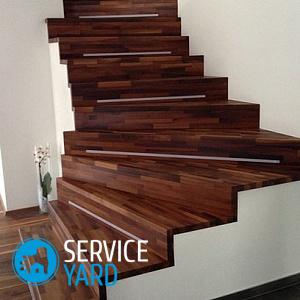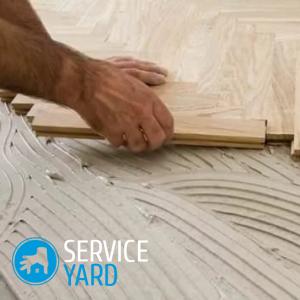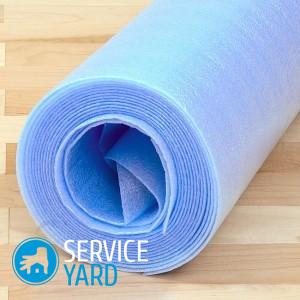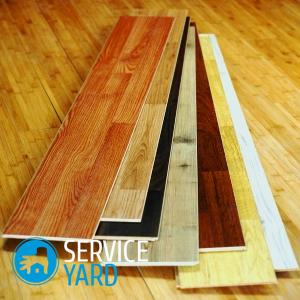Laminate stairs

An integral part of the interior of any country house is an internal staircase. It is important that it has a beautiful finish, is resistant to various factors of wear. An ideal material for the design of such structures is a laminate. Outwardly, it is not much different from natural wood, but at the same time it ensures low noise when walking. Its main advantages are low cost, ease of processing, the ability to easily replace broken or worn parts. Today we will tell you how to finish a staircase with a laminate with your own hands in the presence of a modest budget.
to contents ↑Laminate Basics
Laminate is a multilayer finishing material, which is distinguished by its special wear resistance, water resistance, and shock resistance.
To choose the material suitable for work, use these tips:
- If the steps of the stairs that you plan to finish are subjected to daily intense loads, it is better to use a laminate with a class of at least 31 for this.
- When choosing a material, first of all, you should pay attention to its thickness - on sale there are models with a thickness of 6, 7, 8, 10, 12 mm. And the thicker the panels, the easier it will be to work with them. It is also worth noting that a thick coating during operation is quieter, for a long time it can withstand abrasion and mechanical wear. Pay attention to the width of the boards.
- For stairs, models with lock joints on the tread are suitable.
- A rather important characteristic when choosing a material is also the class of formaldehyde used in the manufacturing process. It is important that the staircase is faced with a laminate that is absolutely safe for health. In this regard, the best option is the class E1 model, which has a certificate of compliance with the latest European norms and standards.
- We cannot ignore the presence of a guarantee from the manufacturer - the average service life of such coatings is 2-6 years. Based on this, we conclude that the staircase should be designed with material with a guarantee of quality for a maximum period.
- Not the least role is played by the cost of products, so the choice largely depends on the financial capabilities of customers.
- Laminate should fit into the overall interior of the house, not slip, combined with the facing of the risers.
How to prepare the stairs for finishing work?
Laminate is simply an exterior finish, it does not have sufficient bearing capacity and cannot provide the desired level of structural reliability of the structure itself. That is why one of the most important stages is preparation.
Important! Even before going to the store for coverage, you need to calculate the required number of panels. Just take measurements from the widest tread, multiply the resulting area by the total number of steps. The same calculation should be made with risers. After finding out how much laminate you need, go and buy it in a store.
Immediately you can’t get down to business, because the material needs to be acclimatized.Leave closed packages for several days in a room with a stable temperature in excess of 18 degrees and a relative humidity of at least 70%.
Prepare the stairs for finishing according to this instruction:
- Check first how reliable the steps are. If any of them break or become unusable, replace or repair them. If your staircase is made of wood, then you need to make sure that all its parts are installed securely, if necessary, fasten them with self-tapping screws. Damaged or worn steps must be replaced and leveled with plywood or a special mixture.
- Get rid of the remnants of the old finish. Clean all surfaces from dirt and peeling paint, otherwise - it will adversely affect the quality of installation of the laminate.
- Treat the structure with a special anti-fungal strengthening composition, then varnish.
- Paint or varnish the railing.
- Flush all the ledges on the steps with risers, cut off the excess or fill it with plywood.
- Clean work surfaces from dirt and dust.
- Prepare a template for cutting material. It can be made of cardboard or other material, according to the shape of standard steps.
What additional materials and tools will be required to work?
- Doing the staircase with a laminate with your own hands, as a rule, is carried out using a special parquet adhesive, a profile fastener system or “liquid nails”.
- Of the tools you need a hammer, a saw on a tree or an electric jigsaw, a notched trowel, a tape measure, a pencil, usually spacer wedges.
- At the approaches, laying is done by means of a special insulating substrate. Thanks to it, a high level of sound insulation, the overall stability of the coating to serious loads is ensured. Plus, it performs waterproofing and thermal insulation functions.
Important! If you just need to provide sound insulation, you can use a thin film of polyethylene 2 mm thick. Whatever option of the substrate you choose, you will have to fix it properly on the plane of each step. Risers are only subject to facing, so it is enough to simply prepare them for installing the laminate.
What substrate to use under the laminate?
The main load on any staircase is in the middle of the front edge of the tread, which means that this section must be properly protected from premature wear by means of metal or plastic plates or a special profile. It is better to prepare these elements in advance by completing the required number of holes for fasteners for more reliable fixation.
Important! In order not to mix up overlays or profiles during the work, number them in the same way as a laminate for facing treads and risers.
A little about fasteners
If the steps of the stairs are finished with laminate using self-tapping screws, then during the purchase of the material, make sure that they have a high-quality protective coating, for example, from zinc, copper or brass.
to contents ↑Important! Note that the steps in height should not differ by more than 1 cm. Such an exception is allowed only for the very first step, more often it differs slightly from the rest in width and height. If all the steps are uneven, then there will be problems with the operation of the stairs.
How to cut a laminate?
As a rule, the type of the lock connection of the material is indicated directly on the packaging, and recommendations regarding work with it are indicated in the instructions from the manufacturer. Moreover, they must be strictly observed in order to exclude unplanned consumption or damage during processing.
Regardless of how the panels are made, immediately before installation, it is necessary to process their lobes and end faces with glue.You have already prepared the template, adjusted the height of the steps and risers to the same size, the staircase is ready for decoration, which means it’s time to cut the material, prepare the end strips, corners.
Important! The edge of each panel must be adjusted to the geometry of the risers and treads. Carefully monitor all sizes, because at the ends the corners can be indirect.
Today, in the construction industry, two methods of corner facing of steps with a laminate are used:
- On a specialized profile. This system involves the simultaneous use of self-tapping screws (fixing the profile) and glue (fixing the laminate).
- With L-shaped nut. It can be mounted openly (metal) or hidden (wood, plastic). In the first case, it is better to fix it on self-tapping screws, in the second - with glue.
Before cutting, be sure to determine the method of fixing the lining. It is important that its lower edge rests on special leveling stands made of solid material:
- The thickness of the supports should correspond to the thickness of the panels for treads.
- When using a specialized and L-shaped profile, the upper edge should be flush with the base of the tread.
to contents ↑Important! Make sure that the profile, cut-out panels or sills clearly lie on the appropriate steps. It is unacceptable the presence of protrusions or gaps, everything should be adjusted with maximum accuracy.
How to laminate an internal staircase?
Finishing a concrete staircase with a laminate starts from the top step. Thus, you will not stamp on the newly laid floor and at the end of work you will remain at the very bottom of the stairs. If you have already completed all of the above recommendations, prepared, calculated everything, then it's time to get down to business.
Make the staircase a laminate by following this instruction:
- Install special pads for support at the junction of treads and risers, so that you can push the horizontal coating under the edge of the vertical laminated cladding.
- Apply glue to the risers, firmly press the facing panel to it, fix it in this position with the help of expansion wedges.
- If you decide to use a profile-nut, then apply glue to its back side, then press the material more firmly to the corners of the step, fix it with spacers or self-tapping screws.
- Apply glue evenly on the tread, spread over its surface with a notched trowel.
- On the tread treated with glue, lay the laminate. If this is the topmost step, then connect the padlock panel to the padlock with the flooring.
- Install a plastic or rubber insert on the edge profile, then attach the insert profile to it.
- Having completed the design of the upper step, move on, gradually approaching the very bottom of the stairs.
to contents ↑Important! In the case of using the L-shaped doorstep, a ladder made of a laminate with his own hands is created almost by the same principle. The only difference is in joining the trailing edge of the nut and the panel on the tread. It often occurs lock to lock, but there are exceptions that require the presence of additional profiles for docking with a door sill and fixing panels.
Stock footage
If you calculate everything correctly, purchase a sufficient amount of material, then there will be no problems with laying. Good luck with your repair!








